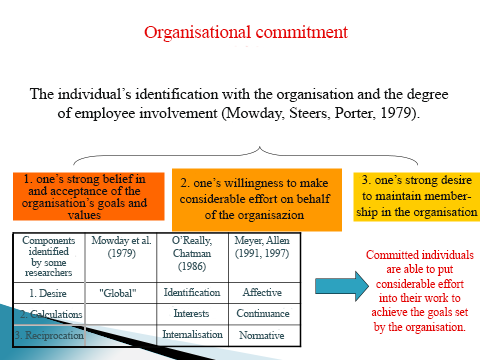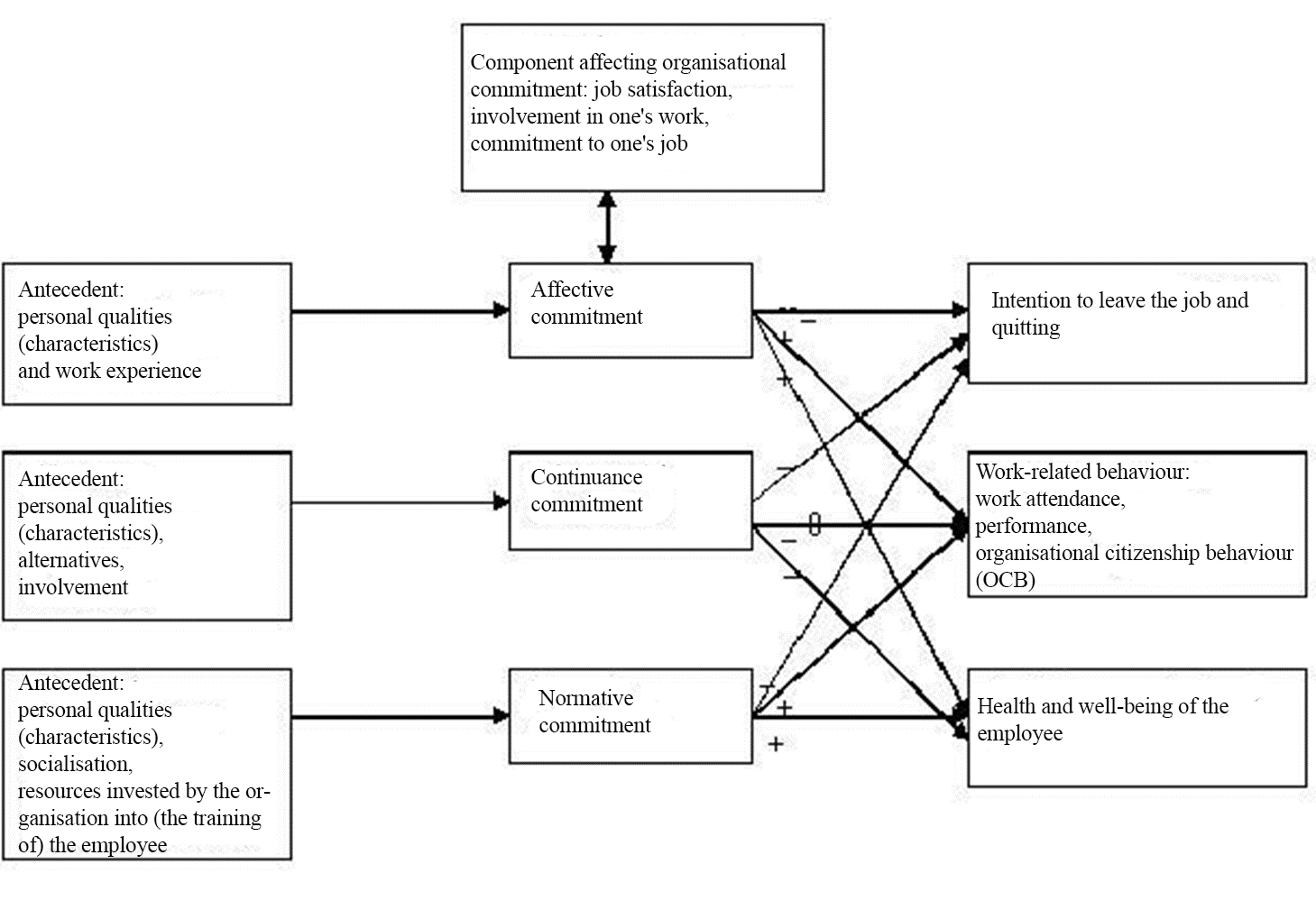The three-component model of organisational commitment
Meyer and Allen (1981) analysed a number of one-dimensional models of organisational commitment in order to detect different factors related to the emergence of this phenomenon in distinct theories. The following three types of commitment appeared in most of the studies they looked at: commitment based on emotions, commitment based on the calculation of costs, and commitment based on obligations.
According to Meyer and Allen, these three types are present at the same time when organisational commitment develops; however, each component is based on different experience and does not affect behaviour in the same way.
The three dimensions are defined in the following way:
- Affective commitment: refers to the employee's positive emotional attachment to the organisation. Such an individual also strongly identifies with the goals of the organisation and desires to maintain his membership. Individuals are committed to an organisation because they “want to”. This dimension is based on Mowday et al.’s (1979) theory of commitment.
- Continuance commitment: refers to an employee’s commitment to an organisation due to the fact that he calculates how high the costs of losing one’s organisational membership are. Such considerations might include economic costs (for instance, pension accruals) and social costs (relationships/friendships with colleagues might cease to exist) too. Individuals feel that they “have to” commit to the organisation.
- Normative commitment: refers to an individual’s commitment an organisation because of feelings of obligation. Such feelings might derive from the fact, for example, that the organisation invested a certain amount of resources when employing the person (trainings, courses, etc.), which makes the employee feeling obliged to put considerable effort into the job and stay with the organisation until “repaying the debt”. Furthermore, such feelings can also stem from personal reasons, triggered by some socialisation processes, or one wishes to remain loyal to his family or any other person. Therefore, the employee stays with the organisation because he "ought to" do so. These feelings arise out of a sense of duty or obligation. This particular component is affected largely by one’s personal experience, cultural background, and socialisation. There are cultures, for example, that of the Japanese, which are characterised by normative commitment, whereas affective commitment is typical of the Americans (János, 2005).
Figure 24 represents different types of commitment in various models and the concept of the same.

Figure 24: A summary of how organisational commitment is defined by different scholars
Meyer and Allen (1991) also studied how distinct commitment types affect employees’ behaviour at the workplace and the well-being of workers.
The effects of affective commitment:
- It correlates negatively with employees’ intention to quit
- It correlates positively with work attendance, performance, organisational citizenship behaviour (OCB) [1], and the health and well-being of employees
The effects of continuance commitment:
- It correlates negatively with employees’ intention to quit
- It correlates negatively or neutrally with attendance, performance, organisational citizenship behaviour (OCB), and the health and well-being of employees
The effects of normative commitment:
- It correlates negatively with employees’ intention to quit
- It correlates positively with attendance, performance, organisational citizenship behaviour (OCB), and the health and well-being of employees
Factors leading to/generating organisational commitment and the possible consequences of the same are represented by Figure 25 below.

Figure 25: The three-component model of organisational commitment on the basis of Meyer and Allen’s (1991, 1997) work
Meyer and Allen (1991) assumed that the affective, continuance and normative commitment are clearly distinguishable components of commitment (see also Field, 2000). Later results of factor analysis mostly supported it (Dunham, Grube, Castenada 1994, Hackett Bycio, Hausdorf 1994, Meyer, Allen, Gellatly, 1990) [2]. Further research has found that the correlation between affective and normative commitment is so strong that some people have raised the question whether there is a need for a separate measure to evaluate the normative commitment.
Meyer et al (2002) have tested the validity of the three-dimensional model on broad empirical database. A questionnaire developed by Meyer and Allen (1991) was applied in this study, which allows the identification of the three previously mentioned components of commitment. The data obtained from the questionnaire was compared to the Organizational Commitment Questionnaire (referred to as OCQ). In doing so, the components and factors of commitment were compared on the basis of previous publications, by doing a meta-analysis. Those results are going to be highlighted below which are relevant to this book.
OCQ[3] highly correlated with the affective commitment (.88), showed medium correlation with normative commitment (.50) and negatively correlated with continuity (.-02). This confirms that the OCQ is actually closest to measuring affective commitment and high OCQ score can mean high affective and low continuance commitment. Researchers examined how job satisfaction and satisfaction with supervisors are related to the previously mentioned three components of commitment.
Taking job satisfaction into consideration: it shows significant correlation with affective commitment (.65), moderate correlation with normative commitment (.31), and negative correlation with continuance (-.07). The relationship between satisfaction with supervisors and the three components can be interesting: it shows moderate correlation with affective component (.42), insignificant correlation with normative component (.13), and negative correlation with continuance (-.04). As it was also expected, job performance is positively, but not significantly correlated with affective (.16) and normative (.06) components, while it is negatively related to the continuance component (-.07).
The above mentioned relationships can be seen in Table 4[4].
Table 4. The relationship between the three components and other variables, based on Meyer et al (2001)
| OCQ | Job satisfaction | Satisfaction with supervisors | |
|---|---|---|---|
| Affective component | .88 | .65 | .42 |
| Continuance component | .-02 | .-07 | .-04 |
| Normative component | .50 | .31 | .13 |
Meyer and Herscovitch’s (2001) results make it possible to outline the commitment profile of the subjects. According to it, each employee at any time can be characterised by different values and levels of these three components which affect their workplace behaviour (work performance, truancy, absenteeism, resignation, terminating or leaving job).
Consequently, it is possible to distinguish for example pure emotional (high AC[5], low CC, low NC), clear continuance (low AC, high CC, low NC), and pure normative (low C, low CC, high NC) "commitment profiles" and their various combinations as well.
[1] In Meyer, Stanley, Herscovitch, Topolniytsky (2002): Affective, Continuance, and Normative Commitment to the Organization: A Meta-analysis of Antecedents, Correlates, and Consequences, Journal of Vocational Behavior 61., 20-52.
[2] Organizational Citizenship Behaviour: can be defined as a certain type of behaviour that goes beyond the basic requirements of the job. The concept includes all the behaviours that are not explicitly recognized by the formal reward system of the organisation, but depend on the judgement of the individual and promote the effective and successful functioning of the organisation. Behaviours such as altruism, conscientiousness, courtesy, fair-mindedness, etc. all belong to this category. For further details, see Dennis Organ (1988) or the article under the following link: http://en.wikipedia.org/wiki/Organizational_citizenship_behavior.
[3] Organizational Commitment Questionnaire, measuring organizational commitment, which captures the affective factor of the three components (Allen, Meyer, 1991).
[4] Dunham, Gruber, Castaneda (1994) found that affective commitment can be the predictor of attitudes towards the organization by 72%, such as career-satisfaction, while normative commitment explains 36% and the continuance commitment explains 7% of the variance (In Robbins, Judge, 2007).
[5] AC: affective commitment, CC: continuance commitment, NC: normative commitment.